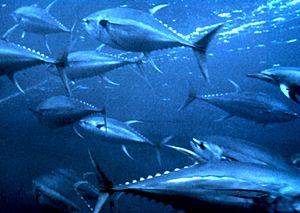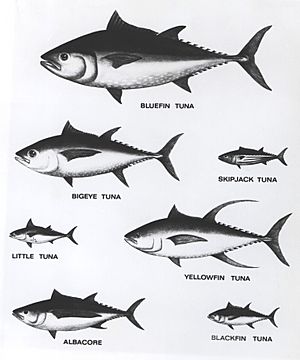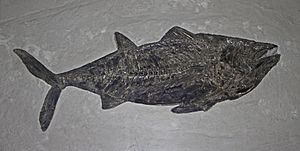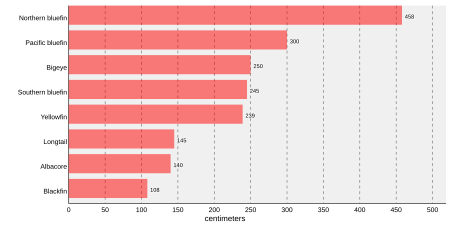True tunas facts for kids
Quick facts for kids True tunas |
|
|---|---|
 |
|
| Yellowfin tuna | |
| Scientific classification |
|
| Kingdom: | Animalia |
| Phylum: | Chordata |
| Class: | Actinopterygii |
| Order: | Scombriformes |
| Family: | Scombridae |
| Tribe: | Thunnini |
| Genus: | Thunnus South, 1845 |
| Type species | |
| Scomber thynnus Linnaeus, 1758
|
|
| Subgenus | |
|
|
| Synonyms | |
|
|
Thunnus is a group of amazing ocean fish. They are part of the mackerel family, called Scombridae. These fish are also known as true tunas or real tunas. There are eight different kinds of Thunnus tuna. They are split into two main groups.
These tunas have cool coloring. Their backs are metallic blue, and their bellies are shiny silver-white. This helps them hide from other animals. From above, they blend with the deep blue water. From below, they blend with the bright surface.
Some tunas, like the Atlantic bluefin tuna, can get very big. They can grow up to 15 feet (4.6 m) long. They can also weigh as much as 1,500 pounds (680 kg). All tunas are super fast swimmers. The yellowfin tuna can swim up to 50 miles per hour (80 km/h) when chasing food!
What's special about Thunnus tunas is that they are warm-blooded. Most fish are cold-blooded. Being warm-blooded helps tunas live in cold water. It also lets them dive very deep. For example, bluefin tunas live in cold places like Newfoundland and Iceland. But they also go to warm places like the Gulf of Mexico and the Mediterranean Sea to lay their eggs.
Sadly, too many of these fish have been caught. This is called overfishing. Because of this, Thunnus tunas are not found in as many places as before. For instance, they have almost disappeared from the Black Sea.
Contents
What's in a Name?
The name Thunnus comes from an old Latin word. That word came from the Greek word thýnnos. It means "tuna" or "to rush" or "to dart." The famous writer Homer was the first to use this word a long time ago.
True Tuna Families
Scientists group Thunnus tunas into two main families, or subgenera. These are Thunnus (Thunnus) and Thunnus (Neothunnus).
- Thunnus (Thunnus) is known as the bluefin group.
- Thunnus (Neothunnus) is known as the yellowfin group.
Scientists used to sort tunas by looking at their bodies. They also looked at tiny bits of their DNA. But new studies using different DNA have changed some ideas. These studies suggest that some tunas might be grouped differently. For example, some think the Bigeye Tuna might belong with the yellowfin group instead of the bluefin group.
This group of tunas has eight different kinds, split into two main families:
- Subgenus Thunnus (Thunnus) (the bluefin group):
- Albacore, T. alalunga
- Southern bluefin tuna, T. maccoyii
- Bigeye tuna, T. obesus
- Pacific bluefin tuna, T. orientalis
- Atlantic bluefin tuna, T. thynnus
- Subgenus Thunnus (Neothunnus) (the yellowfin group):
- Yellowfin tuna, T. albacares
- Blackfin tuna, T. atlanticus
- Longtail tuna, T. tonggol

| The True Tunas of the genus Thunnus, within the Family Scombridae | ||||||||||||||||||||||||||||||||||||||||||||||||||||||||||||||||||||||||
|
||||||||||||||||||||||||||||||||||||||||||||||||||||||||||||||||||||||||
| This diagram shows how Thunnus tunas are related to other fish. Thunnus is one of five groups that make up the Thunnini tribe. It includes 8 of the 15 types of tuna alive today. |
| Another Way to Look at Thunnus Families | |||||||||||||||||||||||||||||||||||||||||||||
|
|||||||||||||||||||||||||||||||||||||||||||||
| This diagram shows a different way scientists think Thunnus tunas might be related. It's based on new DNA studies. It suggests that Bigeye Tuna (Thunnus obesus) might be part of the yellowfin group, not the bluefin group. |
Different Kinds of True Tunas
For a long time, people thought there were seven types of Thunnus tuna. They also thought that Atlantic bluefin tuna and Pacific bluefin tuna were just different versions of the same fish. But in 1999, a scientist named Collette showed they are actually different kinds of fish. He looked at their bodies and their DNA to figure this out.
-
Thunnus, the true tunas Image Common name Scientific name Maximum
lengthCommon
lengthMaximum
weightMaximum
ageTrophic
levelSource IUCN status Thunnus (Thunnus) – the bluefin group 
Albacore tuna T. alalunga
(Bonnaterre, 1788)1.4 m
(4.6 ft)1.0 m
(3.3 ft)60.3 kg
(133 lb)9–13 yrs 4.31  Least Concern
Least Concern
Southern bluefin tuna T. maccoyii
(Castelnau, 1872)2.45 m
(8.0 ft)1.6 m
(5.2 ft)260 kg
(570 lb)20–40 yrs 3.93  Endangered
Endangered
Bigeye tuna T. obesus
(Lowe, 1839)2.5 m
(8.2 ft)1.8 m
(5.9 ft)210 kg
(460 lb)5–16 yrs 4.49  Vulnerable
Vulnerable
Pacific bluefin tuna T. orientalis
(Temminck & Schlegel, 1844)3.0 m
(9.8 ft)2.0 m
(6.6 ft)450 kg
(990 lb)15–26 yrs 4.21  Near Threatened
Near Threatened
Atlantic bluefin tuna T. thynnus
(Linnaeus, 1758)4.6 m
(15 ft)2.0 m
(6.6 ft)684 kg
(1,508 lb)35–50 yrs 4.43  Least Concern
Least ConcernThunnus (Neothunnus) – the yellowfin group 
Blackfin tuna T. atlanticus
(Lesson, 1831)1.1 m
(3.6 ft)0.7 m
(2.3 ft)22.4 kg
(49 lb)4.13  Least concern
Least concern
Longtail tuna,
northern bluefin tuna,
tongol tunaT. tonggol
(Bleeker, 1851)1.45 m
(4.8 ft)0.7 m
(2.3 ft)35.9 kg
(79 lb)18 years 4.50  Data deficient
Data deficient
Yellowfin tuna T. albacares
(Bonnaterre, 1788)2.4 m
(7.9 ft)1.5 m
(4.9 ft)200 kg
(440 lb)5–9 yrs 4.34  Least Concern
Least Concern
Why Tunas Need Our Help
People around the world love to eat tuna, especially in dishes like sushi and sashimi. More and more people are eating tuna. This has led to too many tunas being caught. This is called overfishing. Bluefin tuna is especially at risk. It is a serious concern for people who work to protect animals.
It's hard to manage tuna fishing because these fish travel very far. They swim across huge parts of the ocean. These areas are not owned by any one country. So, fishing boats from many countries can catch them. This makes it hard to agree on rules and make sure everyone follows them.
Some countries, like Japan and Australia, have tried to farm tuna. This means raising them in special pens. But tuna grow very slowly. This makes it harder to farm them than other fish. So, farmed tuna is still very expensive. For example, in 2012, a huge bluefin tuna weighing 222-kilogram (489 lb) was sold for a record $1.76 million in Tokyo!
See also
 In Spanish: Thunnus para niños
In Spanish: Thunnus para niños



